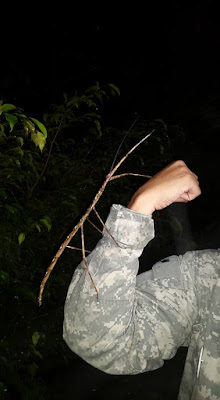On this occasion we were invited to spend a weekend in a lodge at Río Indio, Coclé, on a village located north to El Valle de Antón, and close to where the river of same name is born. Río Indio river flows into the Caribbean on the Colón Province. Therefore, this location is technically on the Caribbean slope disregarding the close distance to the Pacific Ocean.
Two photographers (Miguel and Julio) took a loaned four wheel drive SUV and filled it with our photographic gear and supplies, leaving Panama City at noon. We rode to El Valle de Antón where we had lunch, then followed the directions given by the lodge owner arriving to our destination without trouble, passing several steep slopes and tributary streams that required the use of all wheel drive. The last slope and the river itself are not passable on car, so we had to walk a short distance to arrive to the lodge.
The lodge is impressive, it's located at 900 meters (2,950 ft) altitude right beside the river, have several rooms, garden areas, refrigerator, some lights, gas and wood stoves, chimney, kitchen implements, and a gasoline plant to power the electrical facilites. Weather was not good but we prepared our gear to make pictures of birds after a flock of Cinnamon Becards were hanging around in the orange tree in the garden. Unfortunately, they left before we could be prepared.
We waited until the evening to have dinner, and then start our macro-aventure, not minding the drizzle. Right in the garden we found our first subjects, Julio observed a snake moving through the bushes, and Miguel immediately recognised it as a non-dangerous species, Blunt-headed Tree Snake (Imantodes cenchoa). So we tried to handle it to make some shots but she was not very collaborative and we received a nice test of stinky piss from it. Later, Miguel found a Giant walking stick and being not able to make a macro photography decided to make a shot with the cellphone to show its actual size.
Giant Stick Insect (Phasmatidae)
That night we spent a couple of hours walking on the river bank and a small trail that goes up to a hill but our findings were basically limited to katydids and walking sticks, including the amazing Moss-mimic Walking Stick.
Blunt-headed Tree Snake (Imantodes cenchoa)
Katydid (Tettigoniidae)
Katydid (Tettigoniidae)
Katydid (Tettigoniidae)
Moss-mimic Stick Insect (Trychopeplus sp.)
Planthopper (Fulgoromorpha)
Stick Insect (Phasmatodea), part of the thorax, the head, the forelegs, and antennae are visible
The following day weather was still bad, showers were coming and going all the time but that didn't stop us to make more pictures. This time around the grounds inside the property. Besides macro-photography we also had some opportunities shooting birds. We followed a family of
Buff-rumped Warblers in the river banks and a pair of
Paltry Tyrannulets that were visiting the orange tree in the garden from time to time to eat
mistletoe berries, but our greatest surprise was a male
Rufous-crested Coquette visiting the flowers in the garden, unfortunately we only saw it but were not able to photograph it, once again we were not ready to shoot.
Other animals that we saw over the weekend were:
Chestnut-backed Antbirds (heard),
toucans (fly by),
Blue-black Grosbeak, Gray-capped Flycatcher, House Wren, Tropical Kingbird, Forest Cottontail or "conejo muleto", Red-tailed Squirrel, and several butterflies. Unfortunately, we were not pleased with the butterfly pictures, definitively we need more practice on that.


Wasp (Apocrita)
Predatory Reduviidae, also known as Assassin Bugs, use their long rostrum to inject a lethal saliva
that liquefies the insides of the prey, which are then sucked out. The
saliva contains enzymes that digest the tissues they swallow. This
process is generally referred to as extra-oral digestion.
Ant-mimic Broad-headed Bug (Alydidae)
At first we thought it was an ant but the lack of mandibles and a sucking mouthpart tell the real story: it is a true bug.
Fungus
Leafhopper (Cicadellidae)
Pleasing Fungus Beetle (Erotylidae)
Lubber Grasshopper - instar (Chromacris psittacus)
A medium sized species which is strikingly attractive striped in green and yellow. It has very beautiful bright orange hind wings which are normally hidden from view until it jumps or flies. It lives and feeds gregariously on the edge of forests where it sits in an exposed position. Toxins are likely to be obtained from the foodplants and it is probable that this provides a defence against predators. Bright warning colours and the gregarious nature of the nymphs support this hypothesis. The nymphs are black on hatching and about 4mm long. They take about 3 - 4 months to mature and during this time become progressively more colourful developing red/black colouration in 2nd and 3rd instar which gradually becomes replaced by blue then green and orange/yellow colouration from 4th instar to adult. Adults live for 5 – 9 months.



The Paltry Tyrannulet (Zimmerius vilissimus), as shown above, has a strong affinity for mistletoe, which gave rise to the old name for the species, Mistletoe Tyrannulet. They also feed upon other small fruits and insects.
Buff-rumped Warbler (Myiothlypis fulvicauda)
Chestnut-headed Oropendolas (Psarocolius wagleri) on a nest in the road to Río Indio
These are Miguel pictures, and on the second part of this report we will feature Julio's shots.
To be continued...

























Comments
Post a Comment